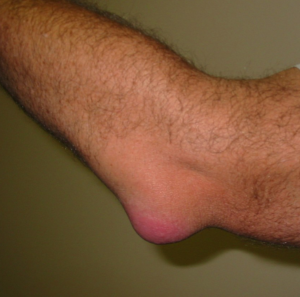Olecranon Bursitis

Olecranon bursitis is a condition in which the bursa, a fluid-filled sac that cushions the joints, becomes inflamed near the olecranon process, which is the bony prominence at the elbow. This condition can cause pain and swelling in the elbow, making it difficult to perform daily activities and leading to limited range of motion. Olecranon bursitis can have a number of different causes, and effective treatment depends on accurate diagnosis and identification of the underlying cause.
Causes of Olecranon Bursitis
Olecranon bursitis can be caused by a number of different factors, including:
• Trauma: Direct trauma to the elbow, such as a fall or a blow to the elbow, can cause olecranon bursitis.
• Repetitive motion: Repetitive motions, such as those involved in certain sports or manual labor, can increase the risk of developing olecranon bursitis.
• Infection: Bacterial or fungal infections can cause olecranon bursitis.
• Medical conditions: Certain medical conditions, such as gout or rheumatoid arthritis, can increase the risk of developing olecranon bursitis.
Symptoms of Olecranon Bursitis
The symptoms of olecranon bursitis may include:
• Pain and tenderness in the elbow
• Swelling in the elbow
• Limited range of motion in the elbow
• Redness and warmth in the affected area
Diagnosis of Olecranon Bursitis
Diagnosis of olecranon bursitis may involve a combination of the following tests:
• Physical exam: A doctor may perform a physical exam to assess the elbow for signs of olecranon bursitis, such as tenderness or swelling.
• X-rays: X-rays may be used to check for any underlying conditions, such as bone fractures or osteoarthritis, that may be contributing to the symptoms.
• Aspiration: A doctor may perform an aspiration, in which a needle is used to remove a sample of fluid from the affected bursa, to check for infection or other underlying causes of olecranon bursitis.
Treatment for Olecranon Bursitis
Treatment for olecranon bursitis depends on the underlying cause of the condition. Treatment options may include:
• Non-surgical treatment: Non-surgical treatment options may include rest, immobilization, and physical therapy. Anti-inflammatory medications may also be prescribed to help manage pain and swelling.
• Surgical treatment: In severe cases of olecranon bursitis, surgery may be necessary. Surgical options may include removal of the affected bursa or drainage of the bursa to relieve pressure and reduce swelling.
Olecranon bursitis is a condition that affects the bursa near the olecranon process of the elbow. It can cause pain, swelling, and limited range of motion in the elbow. Treatment for olecranon bursitis depends on the underlying cause of the condition and may include non-surgical options, such as rest and physical therapy, or surgical options, such as removal of the affected bursa. If you experience symptoms of olecranon bursitis, it is important to seek medical attention as soon as possible to receive an accurate diagnosis and to begin appropriate treatment.
Learn More Here
